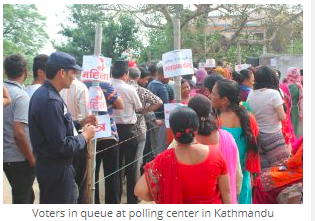Analysis
Factsheet: Electoral Violence and Contestation during Nepal’s Local Election
2017-05-15

Local Level Election, Silence Period and Election Day: First Phase
May 12 – 14, 2017
On May 11 midnight began the silence period for the first phase of local election in Nepal. 4,556,525 registered voters were called upon to elect their representatives for 13,556 positions in 283 local bodies of 34 districts in province 3, 4, and 6 on May 14, 2017. According to the Election Commission voter turnout stood at 71 percent of registered voters. Despite various incidents, some involving deadly violence, both the Election Commission of Nepal and National Human Rights Commission in the evening of May 14 concluded that the first phase of election had been relatively peaceful .
Through its Nepal Peace Monitoring Project, COCAP | NepalMonitor.org gathers data on violence and non-violent contestation in Nepal. Together with the Democracy Resource Center Nepal (DRC-N), COCAP has been releasing periodic analytical updates on incidents related to local elections since March 14. This fact-sheet on election-related incidents between May 12 and 14, 2017 is to complement these updates and is based on preliminary data recorded by NepalMonitor.org by noon 15.05.2017.
Incidents during the silence period and election day, first phase – May 12-14, 2017
By noon May 15, a total of 81 incidents had been recorded, 66 of them violent. Three people were killed and approximately 43 injured in election-related violence. In Dolakha, a Nepali Congress supporter died in a police shooting following a clash between political parties alleging booth capture in Melung. In Naraharinath – 6 of Kalikot a person died shot by police after cadres from the Communist Party of Nepal attempted to loot ballot boxes on Sunday evening. In Bhenighat of Dhading district, a cadre from the Communist Party of Nepal-United Marxist Leninist (CPN-UML) was killed at night. The circumstances of the murder remain unclear.
Following the end of the campaign period on midnight May 11, 2017, the first day of the silence period remained relatively uneventful. Clashes were reported between CPN-UML and Nepali Congress supporters in Beni, Myagdi and in Tanahun. On Saturday, a number of incidents in connection to the bandha announced by the Communist Party Nepal with the aim to disrupt the local election were reported, and explosive devices and hoax bombs found in several places across the country. Cadres of Maoist and CPN-UML clashed in Jajarkot that day. On May 14, 2017, elections started at 7am nationwide and appeared to have gone on without major incidents in most parts of the country. However, disputes between major parties led to clashes in several polling centres in Dolakha, Sindhupalchowk, Ramechhap, Mugu, Humla, Dailekh, Dolpa and Gorkha districts. In most cases, disputes involved supporters of the three major political parties Nepali Congress, CPN-UML, and Maoist Center. In Gorkha, the clash erupted after disputes between Nepali Congress and Naya Shakti. A particular flashpoint was Tamakoshi and Melung rural municipalities in Dolakha, where situation had been tense from the morning in several polling centers.
Due to clashes, voting had to be temporarily halted in some polling centers of Ramechhap, Dolakha, Sindhupalchok, Bhaktapur, Dailekh, Gorkha, Humla, and Mugu Districts. In Dulikhel Municipality – 12, Kavre, elections had been postponed after the death of a candidate on May 11. In Namobouddha municipality of Kavre, residents protested the killing of a youth on May 13. They alleged he had been shot by Armed Police Force and refused to participate in the election.In Namobuddha, Kalika of Kalikot and Melung rural municipality of Dolakha voting has been suspended.
To download the fact sheet with more details, please click here.
For an updated list of election-related incidents in May, please click here.

